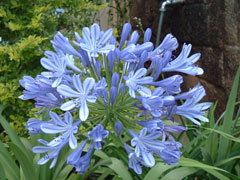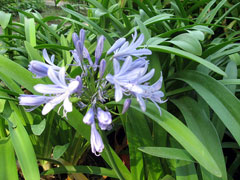 |
|
http://commons.wikimedia.org/wiki/User:Conrado |
 |
| http://cs.wikipedia.org/wiki/Wikipedista:Dezidor |
Translate this page:
Summary
Bloom Color: Blue.
Main Bloom Time: Early fall, Late summer. Form: Irregular or sprawling, Spreading or horizontal, Upright or erect.
Physical Characteristics

 Agapanthus africanus is an evergreen Bulb growing to 1 m (3ft 3in) by 0.5 m (1ft 8in) at a medium rate.
Agapanthus africanus is an evergreen Bulb growing to 1 m (3ft 3in) by 0.5 m (1ft 8in) at a medium rate.
See above for USDA hardiness. It is hardy to UK zone 9 and is not frost tender. It is in leaf all year, in flower from July to September. The species is hermaphrodite (has both male and female organs) and is pollinated by Bees.
Suitable for: light (sandy) and medium (loamy) soils and prefers well-drained soil. Suitable pH: mildly acid, neutral and basic (mildly alkaline) soils. It can grow in semi-shade (light woodland) or no shade. It prefers moist soil. The plant can tolerate maritime exposure.
UK Hardiness Map
US Hardiness Map
Synonyms
A. umbellatus. pro parte
Plant Habitats
Cultivated Beds;
Edible Uses
References More on Edible Uses
Medicinal Uses
Plants For A Future can not take any responsibility for any adverse effects from the use of plants. Always seek advice from a professional before using a plant medicinally.
Cardiac Stomachic
Cardiac, stomachic[61].
References More on Medicinal Uses
The Bookshop: Edible Plant Books
Our Latest books on Perennial Plants For Food Forests and Permaculture Gardens in paperback or digital formats.

Edible Tropical Plants
Food Forest Plants for Hotter Conditions: 250+ Plants For Tropical Food Forests & Permaculture Gardens.
More

Edible Temperate Plants
Plants for Your Food Forest: 500 Plants for Temperate Food Forests & Permaculture Gardens.
More

More Books
PFAF have eight books available in paperback and digital formats. Browse the shop for more information.
Shop Now
Other Uses
References More on Other Uses
Cultivation details
Landscape Uses:Border, Container, Foundation, Massing, Specimen. Succeed in most soils[175], but prefers a light very well-drained porous soil with plenty of leaf-mold[1, 200]. Plants need to be kept moderately dry during the growing season but with some moisture in winter[1]. They only flower freely if growing in a very sunny position[175]. Plants succeed in maritime gardens[233]. The rhizomes are best planted only just below soil level - a mulch of gravel or stone chips will help to keep the crown of the plant free from excess moisture[282]. This species does not usually do well in cultivation[282]. In the wild it usually only flowers freely in the year following a bush fire[282]. This species is not very hardy in Britain[1], but some forms of the plant tolerate several degrees of frost[200]. They are best given a good mulch if temperatures lower than 0°c occur[200]. Plants are growing well at the foot of a wall in Cambridge Botanical Gardens[K]. Hybridizes very freely with other members of this genus, some botanists say there is only one very variable species of Agapanthus[200]. Plants seem to be immune to the predations of rabbits[233]. The flowering stems lean towards the sun[175]. Special Features:
Attractive foliage, Not North American native, Naturalizing, Attracts butterflies, Suitable for cut flowers, Suitable for dried flowers, Attractive flowers or blooms.
References Carbon Farming Information and Carbon Sequestration Information
Temperature Converter
Type a value in the Celsius field to convert the value to Fahrenheit:
Fahrenheit:
The PFAF Bookshop
Plants For A Future have a number of books available in paperback and digital form. Book titles include Edible Plants, Edible Perennials, Edible Trees,Edible Shrubs, Woodland Gardening, and Temperate Food Forest Plants. Our new book is Food Forest Plants For Hotter Conditions (Tropical and Sub-Tropical).
Shop Now
Plant Propagation
Seed - best sown in a greenhouse as soon as it is ripe[200], it can also be sown in a greenhouse in March/April[133]. The seed usually germinates in 1 - 3 months at 18°c[133], do not sow it too thickly so that it is possible to grow the seedlings on in their pot without disturbing them for their first year of growth. Give occasional liquid feeds to make sure they do not become nutrient deficient. Divide the seedlings up into individual pots in the spring following germination, grow them on for a further year in the greenhouse and then plant them out into their permanent positions in late spring or early summer. Seedlings take 2 - 3 years to flower[133]. Division of offsets in April/May. Do not move plants between October and March[175]. Division is very easy in the growing season, the divisions can be planed straight out into their permanent positions if required.
Other Names
If available other names are mentioned here
Native Range
AFRICA: South Africa (Western Cape)
Weed Potential
Right plant wrong place. We are currently updating this section.
Please note that a plant may be invasive in one area but may not in your area so it's worth checking.
Conservation Status
IUCN Red List of Threatened Plants Status :

Growth: S = slow M = medium F = fast. Soil: L = light (sandy) M = medium H = heavy (clay). pH: A = acid N = neutral B = basic (alkaline). Shade: F = full shade S = semi-shade N = no shade. Moisture: D = dry M = Moist We = wet Wa = water.
Now available:
Food Forest Plants for Mediterranean Conditions
350+ Perennial Plants For Mediterranean and Drier Food Forests and Permaculture Gardens.
[Paperback and eBook]
This is the third in Plants For A Future's series of plant guides for food forests tailored to
specific climate zones. Following volumes on temperate and tropical ecosystems, this book focuses
on species suited to Mediterranean conditions—regions with hot, dry summers and cool, wet winters,
often facing the added challenge of climate change.
Read More
Expert comment
Author
(L.)Hoffman.
Botanical References
73200
Links / References
For a list of references used on this page please go here
Readers comment